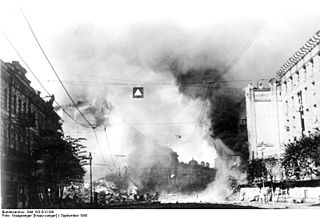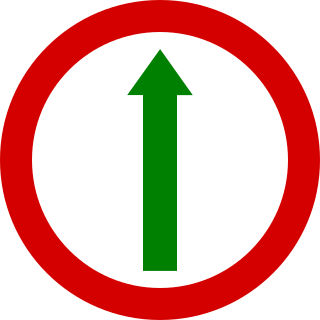
The Third Battle of Kharkov was a series of battles on the Eastern Front of World War II, undertaken by Army Group South of Nazi Germany against the Soviet Red Army, around the city of Kharkov between 19 February and 15 March 1943. Known to the German side as the Donets Campaign, and in the Soviet Union as the Donbas and Kharkov operations, the German counterstrike led to the recapture of the cities of Kharkov and Belgorod.

The 6th Army was a field army of the German Army during World War II. It is widely known for its defeat by and subsequent surrender to the Red Army at the Battle of Stalingrad on 2 February 1943. It committed war crimes at Babi Yar while under the command of Field Marshal Walther von Reichenau during Operation Barbarossa.

The First Battle of Kiev was the German name for the major battle that resulted in an encirclement of Soviet troops in the vicinity of Kiev during World War II, the capital and most populous city of the Ukrainian Soviet Socialist Republic. This encirclement is the largest encirclement in the history of warfare by number of troops. The battle occurred from 7 July to 26 September 1941 as part of Operation Barbarossa, the Axis invasion of the Soviet Union.

The Battle of Rostov (1941) took place on the Eastern Front of World War II around Rostov-on-Don and was fought between Army Group South of Nazi Germany and the Southern Front of the Soviet Union.

The 71st Infantry Division Kleeblatt was an infantry division of the German Army, raised on 26 August 1939, shortly before the outbreak of World War II, as a division of the 2nd wave of deployment by Infantry Commander 19 in Hildesheim. It fought in Verdun, Stalingrad and Monte Cassino, among others.

III Army Corps was a corps level formation of the German Army during World War II.
The 7th Panzer Division was an armored formation of the German Army in World War II. It participated in the Battle of France, the invasion of the Soviet Union, the occupation of Vichy France, and on the Eastern Front until the end of the war. The 7th Panzer Division is also known by its nickname, Ghost Division.

The 44th Infantry Division was formed on 1 April 1938 in Vienna, about two weeks after the Anschluss of Austria. It first saw combat at the start of the war in the Invasion of Poland, and also took part in the Battle of France in 1940. After a 9-month period of coastal defence the division was transferred East. On 22 June 1941, the division took part in the invasion of the Soviet Union, attached to Army Group South. It remained in the east after the failure of "Operation Barbarossa", taking part in defensive actions for the winter against the Soviet Army offensives near Izum and Kharkov. Refurbished, the division participated in the German summer offensive, and was subsequently destroyed with the 6th Army at Stalingrad in January 1943.

The Battle of the Sea of Azov, also known as the Chernigovka pocket was an Axis military campaign fought between 26 September 1941 and 11 October 1941 on the northern shores of the Sea of Azov on the Eastern Front of World War II during Operation Barbarossa. It resulted in a complete Axis victory over the Red Army.

The Belgorod–Kharkov strategic offensive operation, or simply Belgorod–Kharkov offensive operation, was a Soviet strategic summer offensive that aimed to recapture Belgorod and Kharkov, and destroy Nazi German forces of the 4th Panzer Army and Army Detachment Kempf. The operation was codenamed Operation Polkovodets Rumyantsev, after the 18th-century Field Marshal Peter Rumyantsev and was conducted by the Voronezh and Steppe Fronts in the southern sector of the Kursk Bulge. The battle was referred to as the Fourth Battle of Kharkov by the Germans.

The 389th Infantry Division was a German division of the Wehrmacht in the Second World War, which fought for example in the Battle of Stalingrad. It was formed on 27 January 1942 in Milowitz.

The 24th Infantry Division was a German Army infantry division active in World War II. It served across the Eastern Front in engagements such as the Sieges of Sevastopol and the Leningrad, finally being destroyed in the Courland Pocket in 1945.

The 88th Infantry Division was a major fighting formation of the German Army (Wehrmacht). It was created in December 1939, and first saw combat in the Battle of France, and was then posted to security duties. From December 1941, the division was shifted to the southern sector of the Eastern Front, where it fought until February 1944 when it was encircled near Cherkassy and virtually destroyed.

The Red Army's 60th Army was a Soviet field army during the Second World War. It was first formed in reserve in the Moscow Military District in October 1941, but soon was disbanded. It was formed a second time in July 1942, and continued in service until postwar. The 60th Army was commanded by Gen. Ivan Danilovich Chernyakhovsky for much of the war, and it was while in this command that he proved himself worthy to be promoted to the rank of General of the Army and command of a Front at the age of 38 years. Elements of the army went on to, among other things, liberate the Auschwitz concentration camp.
The 333rd Rifle Division began forming in the North Caucasus Military District in August, 1941, as a standard Red Army rifle division, as part of the massive mobilization of reserve forces very shortly after the German invasion. In 1942 it served in the late winter and early spring fighting near Kharkov, taking a beating both then and during the opening stages of the German summer offensive. Withdrawn into the reserves, the division was rebuilt in time to take part in the Soviet counteroffensive at Stalingrad in November, and played an important role in driving the German forces out of the Caucasus region during the winter. In the autumn of 1943 the division shared credit with the 25th Guards Rifle Division for the liberation of Sinelnikovo in the Dnipropetrovsk Oblast, receiving that place name as an honorific. After battling through Ukraine and into the Balkan states, the 333rd completed its combat path on a relatively quiet note doing garrison duties in the Balkans.
The 393rd Rifle Division was raised in 1941 as an infantry division of the Red Army, and fought against the German invasion Operation Barbarossa. In its first formation the division followed a very similar combat path to that of the 411th Rifle Division. It was first formed on 1 October in the Kharkov Military District, probably on the basis of militia units that had been raised there. It fought in the Barvenkovo–Lozovaya Offensive that created the Izium - Barvenkovo salient in January 1942 and was intended to play a leading role in a spring offensive aimed at the liberation of Kharkov. In the event a German counteroffensive cut off the salient; the division was deeply encircled and destroyed. In the buildup to the Soviet invasion of Manchuria a new 393rd was formed in the Far Eastern Front in late 1944. The new division fought into the northern part of the Korean peninsula, taking many ports and cities with enough distinction that it was awarded the Order of the Red Banner, and continued to serve briefly into the postwar period.
The 1940 formation of the 160th Rifle Division was an infantry division of the Red Army, formed as part of the prewar buildup of forces, based on the shtat of September 13, 1939. The division completed its formation at Gorki in the Moscow Military District and at the time of the German invasion of the Soviet Union was in the same area, assigned to the 20th Rifle Corps in the Reserve of the Supreme High Command. It was moved west by rail to join the 13th Army of Western Front in the first days of July 1941 in the Mogilev area. At the end of the month the division was assigned to the reserves of Central Front before becoming part of Operations Group Akimenko in the reserves of Bryansk Front. In mid-September it was encircled and forced to break out; in the process it lost its commanding officer, much of its command staff and so many men and heavy weapons that it was briefly written off. Its number was reallocated to the 6th Moscow Militia Division and for the next 18 months there were two 160th Rifle Divisions serving concurrently. By the start of Operation Typhoon at the end of September it was in Operations Group Ermakov; while falling back to southwest of Kursk it managed to avoid encirclement but remained barely combat-effective due to its heavy losses.
The 226th Rifle Division was an infantry division of the Red Army, originally formed as one of the first reserve rifle divisions following the German invasion of the USSR. After being hastily organized it arrived at the front along the lower Dniepr River as part of 6th Army and in the wake of the German victory in the Kiev encirclement it fell back toward, and then past, Kharkiv and spent the winter fighting in this area. During the Second Battle of Kharkov in May 1942 it scored early successes but was soon forced back by counterattacking panzers and barely escaped destruction in the first phases of the German summer offensive. After rebuilding in the Reserve of the Supreme High Command the division returned to the front north of Stalingrad where it joined the 66th Army. It took heavy losses in one of the last efforts to break through to the city before Operation Uranus cut off the German 6th Army, but it still played an important role in the reduction of the pocket during Operation Ring and as a result was redesignated as the 95th Guards Rifle Division in May 1943.
The 228th Rifle Division was an infantry division of the Red Army, originally formed in the months just before the start of the German invasion, based on the shtat of September 13, 1939. After being formed in the Kiev Special Military District it soon took part in the fighting in northern Ukraine where it joined the 5th Army north of Kyiv. The presence of this Army in the fastnesses of the eastern Pripyat area influenced German strategy as it appeared to threaten both the left flank of Army Group South and the right flank of Army Group Center. In September the latter Group was turned south to encircle the Soviet forces defending Kyiv and in the process the 228th was cut off and destroyed.
The 175th Rifle Division was originally formed as an infantry division of the Red Army in the North Caucasus Military District in July 1940, based on the shtat of September 13, 1939. It was still in that District at the time of the German invasion, and it was soon moved to the Kiev Fortified Region as part of Southwestern Front. It would remain defending the Ukrainian capital into September, eventually as part of 37th Army, when it was deeply encircled and destroyed.


















